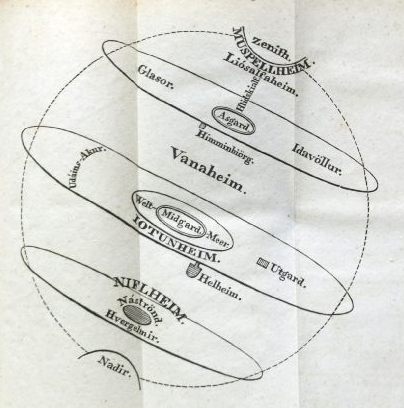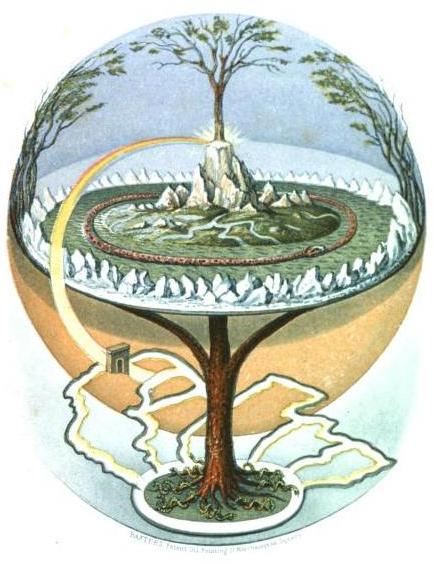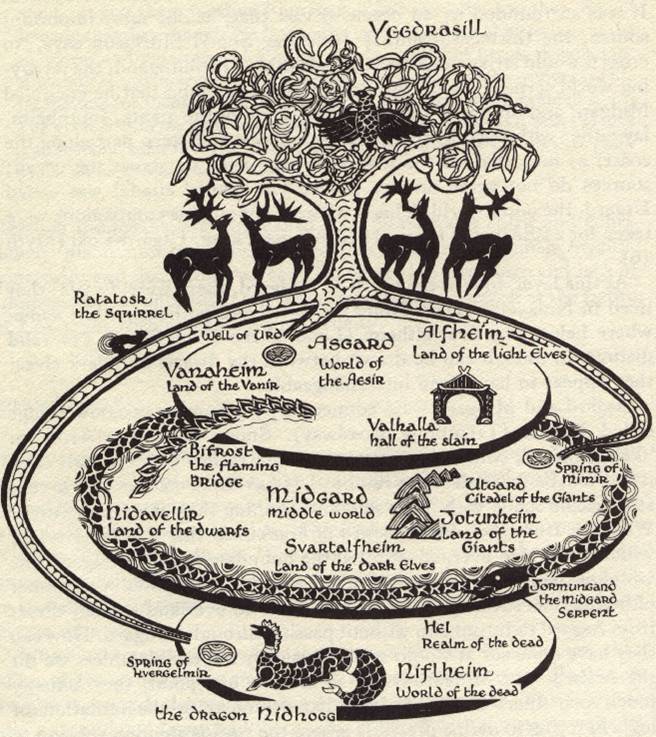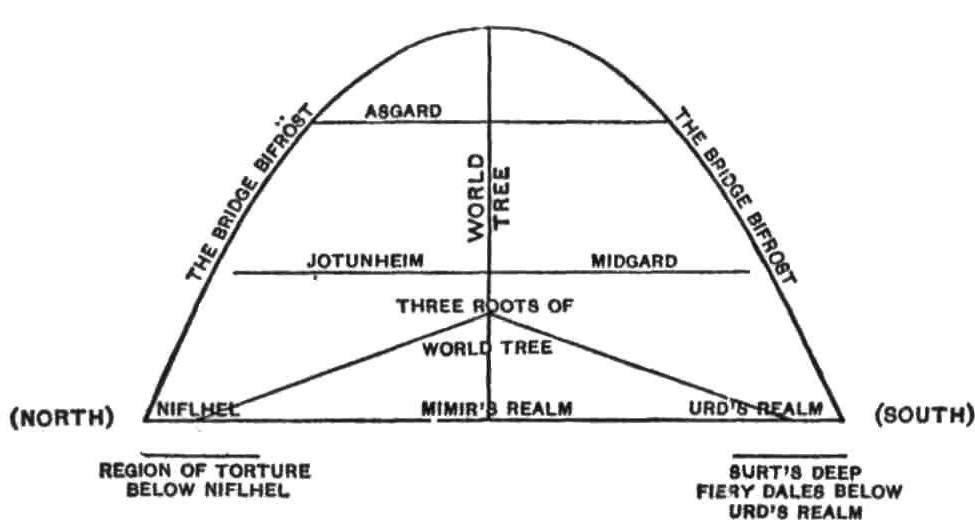|
PIONEERS IN OLD NORSE COSMOLOGY Four Historic Attempts to identify the Nine Worlds [Old Norse Cosmology] [Home] |
||||||||||||||||||||||||||||||||||||||||||||||||
| 6 |
Breaking Ground Finnur Magnússon, 1825
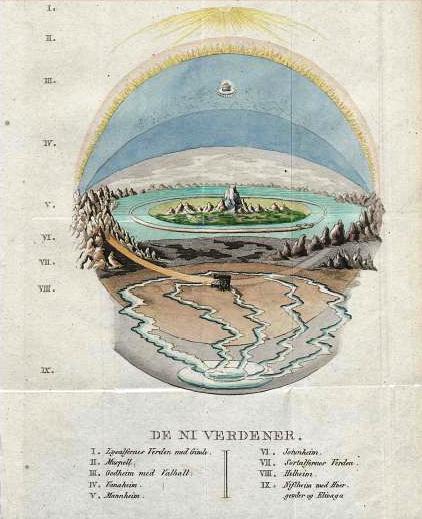
Magnússon already uses the terms "Ljosalfheim" and "Svartalfheim" for two of the worlds, despite the fact that the term Ljosalfheim is not found in the sources. Snorri says that the Ljosalfar (Light-elves) live in Alfheim. He says that the svartalfar (black-elves) live underground. In subsequent chapters, Skirnir rides to "Svartalfheim" to retrieve a chain to bind Fenrir from "dwarves" living there. Ljosalfheim is not the actual name of any worlds. Magnússon likely coined it. Subsequent cartographers have followed suit, although the spelling and the location of these two realms vary (see below). The second attempt to classify the nine worlds is that of Gustav Legis in his Fundgruben des Alten Nordens (1829). His sketch closely mirrors Magnússon's with some subtle nuances. Gustav Legis presents this image of the cosmos:
This time, Muspelheim comes out on top, followed by Ljosalfheim, and then Asgard.
THE FIRST RESPONSE In 1847, a commentary in the revised edition of Paul Henri Mallet's Northern Antiquities, edited by Sir Walter Scott, responded critically to Magnússon's earlier systemization of the nine worlds: "In the third chapter of the Prose Edda, Niflhel is represented as being 'below in the ninth world;' and in the thirty-fourth chapter we are told that Odin cast Hela into Niflheim, and 'gave her power over nine worlds.' In the forty-fifth strophe of Vafthrudnis-mal, the giant tells Gangrad that he has been in nine worlds. These allusions, it must be confessed, are both obscure and contradictory; nevertheless Finn Magnusen gives us a systematic classification of the nine worlds or regions which, according to his notions, were regarded by the Scandinavian mystagogues as constituting the universe. He in fact furnishes us both with a ternary and a nonary vertical division, as follows:"
Paul Henri Mallet writes:
1. THE SUPERIOR OR SUPERNAL WORLD.
1. Ljosalfaheim, in which he places Gimli, where righteous men, after Ragnarok, are to abide with Surtur, the Supreme Deity!!! The heaven Vidblainn separates this region from, 2. Muspellheim, in which are the Flame-spirits!! or Muspell's sons, who are also under the immediate dominion of Surtur, both these regions being uncreated. The heaven Andlang separates Muspellheim from 3. Godheim, where the Æsir abide, and which is, "properly speaking, the ethereal or starry heavens."
II. THE MEDIAL WORLD.
4. Vanaheim or Vindheim—the abode of the Vanir, which he regards as the Spirits of Air; the region itself being the sky or the terrestrial atmosphere. 5. Mannheim; the earth; the abode of mankind. 6. Svartalfaheim; the subterraneous parts of the earth — holes, caverns, &c.; the abode of the Elves of Darkness.
III. THE INFERIOR OR INFERNAL WORLD.
7. Jotunheim; the abode of giants. In this region is also the great ocean with the Midgard serpent. 8. Helheim; the abode of death. 9. Niflheim; the deepest region also uncreated, in which are Hvergelmir and Nastrond.
"If it be asked what authority the learned Icelander can adduce for this classification we must unhesitatingly answer, not the slightest. The distinction which he makes between Ljosalfaheim, and Muspellheim, placing in the former, along with the souls of righteous men, the Elves of Light—or rather leading us to infer that it was originally or will be their abode; and in the latter beings which he is pleased to term Flamespirits, is totally unwarranted That the Vanir are the Spirits of Air dwelling in the atmosphere (Vanaheim) is a mere conjecture, a plausible one, perhaps, but still a conjecture, and it will be needless for us to point out the inconsistency of placing Jötunheim and "the earth-encircling ocean " under the earth, Finn Magnusen himself, when he follows the horizontal instead of the vertical division, ranging them on the same plane with it.* In short, this classification rests on the most groundless assumptions imaginable, and can only be ascribed to that theorizing mania, which it is much to be regretted that a writer of Finn Magnusen's learning should be so apt to indulge in.
"We think, ourselves, that the only admissible division would lie a ternary one, viz.:— 1. The Super-terrestrial Region, or the heavens—the abode of the mundane deities. 2. The Terrestrial Region, which was regarded as an horizontal circular plane. In the middle lay the earth (Midgard), the abode of mankind: the Elves of Darkness and the Dwarfs— probably two designations of the same mythological beings— dwelling beneath its surface in caverns and other subterraneous places. The earth, we are expressly told, was encircled by the vast ocean, the outer shores of which formed the cold, cheerless, and mountainous region of Jotunheim, the abode of the Frost and Mountain Giants, and other typified principles of evil. 3. The Sub-terrestrial Region, or Helheim, the abode of Hela, or Death *.
Muspellheim and Niflheim lay outside of the organized universe, and were obviously regarded as the primordial spheres or material regions of light and darkness, of an active and a passive principle—both mere modifications of matter—the antagonism of which produced this universe, with the Æsir, Vanir, Giants, Dwarfs, and other mythic beings that were popularly supposed to be located in its various regions, though they were no doubt regarded by the initiated as the mere symbols of antagonistic elements."
*Yggdrasill's three roots perfectly correspond to this ternary division. One taking its rise in the Super-terrestrial Region, another at the outer part of the Terrestrial Region, and the third in Helheim; Hela, according to the Grimnis-mal dwelling under it.
With the advance of the Space-Age in the 20th century, artists have tended to depict the worlds more like planets. Over time, the models have gotten less specific, and generally trended toward representing the 9 worlds as individual spheres only loosely connected with Yggdrasil.
Notice that Muspellsheim has now been removed from the top spot, and the Home of the Light-elves is placed below Asgard (eventough Snorri says it is with Gimli in the highest heaven.) The sources (as shown above) do not support this interpretation of the cosmology.
THE POPULAR IMAGINATION At the beginning of the 21st century, Norse Mythology is becoming better known through the media of Comic Books, TV Programs, and Films. Today, the popular view of Yggdrasil and the Nine Worlds is best embodied in popular culture by Marvel Comics' The Mighty Thor, an on-going series, 1962 to present. This entry in the Marvel Universe encyclopedia mapped the Nine Worlds in the following manner:
This diagram is the Marvel Comics version of Old Norse cosmology, suited to meets the needs of their fictional thunder god. Here the nine worlds are:
Notice the inconsistencies between this model and the earlier ones. This is caused by the lack of information in the sources.
Only the place-names Svartalfheim and Alfheim appear in the lore. Ljosalfaheim was coined by Magnússon and subsequently modifed to Ljosalfheim, as a balance to Svartalfheim. Alfheim is the term used in the old Eddic poems. Svartalfheim is only found in Snorri's Edda, as a home of dark-elves or dwarves. Because the nine worlds are never enumerated in the lore, an artist can literally do whatever s/he wants to do. The canvas is blank. All representations of the Nine Worlds to date are a variation of the diagrams presented above. Simrock's has been a particular favorite, having been reproduced in many variations. The singular most popular image of Yggdrasil and Old Norse Cosmology, since the late-1980s, is this image from The Norse Myths by Kevin Crossley-Holland:
|
|||||||||||||||||||||||||||||||||||||||||||||||
| [Old Norse Cosmology] [HOME] | ||||||||||||||||||||||||||||||||||||||||||||||||
